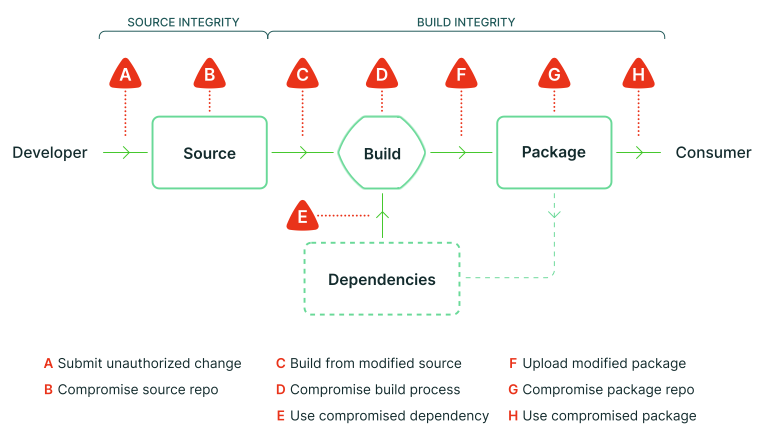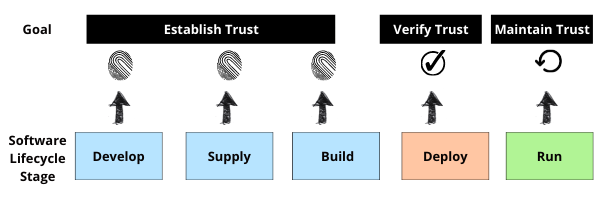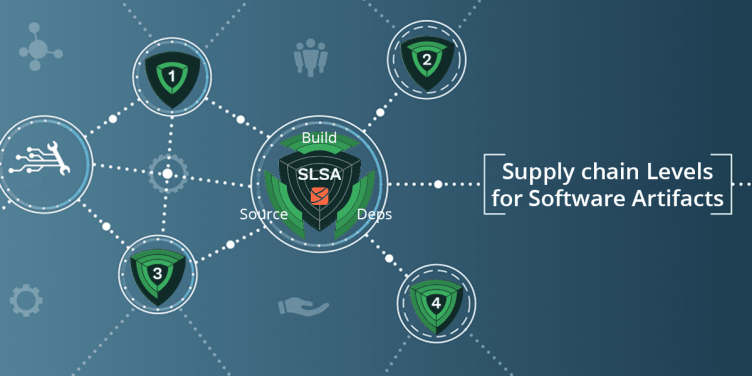The SLSA (Software Artifacts Supply Chain Levels) framework is a way to classify and evaluate the maturity of an organization's supply chain for software artifacts. The framework is based on several levels, each of which represents a higher level of maturity in managing the software artifact supply chain.
✅ In the modern world, it is very important to ensure the cybersecurity of the company. Visit our site https://security.studio, we will help you build information security.
To implement the SLSA framework, an organization should first understand the different levels and the associated best practices for each level. The organization should then assess its current practices and identify areas for improvement.
Level 1: Basic
Level 2: Managed
Level 3: Defined
Level 4: Measured
Level 5: Optimizing
To move from one level to the next, organizations should focus on implementing the best practices associated with the next level, and continuously monitor and improve their practices over time.
It's worth to notice that it is important to use this framework as a guide, not a rule to be strictly followed, as each company may have different regulations, risks and compliance needs.
The SLSA framework can be used as a tool for organizations to improve their supply chain for software artifacts by identifying areas for improvement and implementing best practices at each level.
✅ In the modern world, it is very important to ensure the cybersecurity of the company. Visit our site https://security.studio, we will help you build information security.
To implement the SLSA framework, an organization should first understand the different levels and the associated best practices for each level. The organization should then assess its current practices and identify areas for improvement.
Level 1: Basic
- manual processes
- lack of automation
- little to no traceability
Level 2: Managed
- some automation
- basic traceability
- limited governance
Level 3: Defined
- standardized processes
- formal governance
- robust traceability
Level 4: Measured
- quantitative process performance data
- continuous improvement
- proactive risk management
Level 5: Optimizing
- advanced analytics
- closed-loop process control
- continuous process improvement
To move from one level to the next, organizations should focus on implementing the best practices associated with the next level, and continuously monitor and improve their practices over time.
It's worth to notice that it is important to use this framework as a guide, not a rule to be strictly followed, as each company may have different regulations, risks and compliance needs.
The SLSA framework can be used as a tool for organizations to improve their supply chain for software artifacts by identifying areas for improvement and implementing best practices at each level.

SLSA’s primary focus is supply chain integrity, with a secondary focus on availability. Integrity means protection against tampering or unauthorized modification at any stage of the software lifecycle.
Source integrity: Ensure that all changes to the source code reflect the intent of the software producer. Intent of an organization is difficult to define, so SLSA approximates this as approval from two authorized representatives.
Build integrity: Ensure that the package is built from the correct, unmodified sources and dependencies according to the build recipe defined by the software producer, and that artifacts are not modified as they pass between development stages.
Availability: Ensure that the package can continue to be built and maintained in the future, and that all code and change history is available for investigations and incident response.
Source integrity: Ensure that all changes to the source code reflect the intent of the software producer. Intent of an organization is difficult to define, so SLSA approximates this as approval from two authorized representatives.
Build integrity: Ensure that the package is built from the correct, unmodified sources and dependencies according to the build recipe defined by the software producer, and that artifacts are not modified as they pass between development stages.
Availability: Ensure that the package can continue to be built and maintained in the future, and that all code and change history is available for investigations and incident response.

At Level 1, organizations typically have basic processes in place, but they may be manual and unstructured. There is likely little to no automation or traceability, which can make it difficult to track and manage software artifacts. Best practices at this level include implementing basic policies and procedures, as well as setting up basic traceability mechanisms, such as version control systems.
At Level 2, organizations have implemented some automation and basic traceability. Governance is still limited, and there may be inconsistencies in processes across different parts of the organization. Best practices at this level include implementing standard processes, such as change management, as well as setting up governance mechanisms, such as approvals and audits.
At Level 3, organizations have well-defined processes in place, with formal governance and robust traceability. There is a high degree of consistency in processes across the organization, and the organization has a clear understanding of the lifecycle of software artifacts. Best practices at this level include implementing quantitative metrics for process performance and developing a continuous improvement program.
At Level 4, organizations have implemented quantitative metrics for process performance and have a continuous improvement program in place. They also have a proactive risk management program to mitigate potential supply chain disruptions. Best practices at this level include implementing advanced analytics, such as data visualization and machine learning, to gain insights into supply chain performance, as well as closed-loop process control to make real-time adjustments to processes.
At Level 5, organizations have highly optimized processes in place, with advanced analytics and closed-loop process control. They also have a culture of continuous process improvement and are always looking for ways to optimize their supply chain for software artifacts.
It is important to note that the SLSA framework is intended to be a guide, not a strict rule to be followed. Each organization's supply chain for software artifacts is unique, and the framework should be used in a way that is appropriate for the organization. Additionally, each level of maturity can be reviewed and re-evaluated over time as the organization's processes or needs change.
✅ In the modern world, it is very important to ensure the cybersecurity of the company. Visit our site https://security.studio, we will help you build information security.
#soc2 #iso27001 #cybersecurity #informationsecurity #compliances #cyberdefense #infosec #securityawareness #blueteam #informationsecurity #vulnerability #GDPR #security #privacy #infosec #privacyconsulting #technology #dataprivacy #dataprotection #datasecurity #staking #proofofstake #startup #salsa #devsecops
At Level 2, organizations have implemented some automation and basic traceability. Governance is still limited, and there may be inconsistencies in processes across different parts of the organization. Best practices at this level include implementing standard processes, such as change management, as well as setting up governance mechanisms, such as approvals and audits.
At Level 3, organizations have well-defined processes in place, with formal governance and robust traceability. There is a high degree of consistency in processes across the organization, and the organization has a clear understanding of the lifecycle of software artifacts. Best practices at this level include implementing quantitative metrics for process performance and developing a continuous improvement program.
At Level 4, organizations have implemented quantitative metrics for process performance and have a continuous improvement program in place. They also have a proactive risk management program to mitigate potential supply chain disruptions. Best practices at this level include implementing advanced analytics, such as data visualization and machine learning, to gain insights into supply chain performance, as well as closed-loop process control to make real-time adjustments to processes.
At Level 5, organizations have highly optimized processes in place, with advanced analytics and closed-loop process control. They also have a culture of continuous process improvement and are always looking for ways to optimize their supply chain for software artifacts.
It is important to note that the SLSA framework is intended to be a guide, not a strict rule to be followed. Each organization's supply chain for software artifacts is unique, and the framework should be used in a way that is appropriate for the organization. Additionally, each level of maturity can be reviewed and re-evaluated over time as the organization's processes or needs change.
✅ In the modern world, it is very important to ensure the cybersecurity of the company. Visit our site https://security.studio, we will help you build information security.
#soc2 #iso27001 #cybersecurity #informationsecurity #compliances #cyberdefense #infosec #securityawareness #blueteam #informationsecurity #vulnerability #GDPR #security #privacy #infosec #privacyconsulting #technology #dataprivacy #dataprotection #datasecurity #staking #proofofstake #startup #salsa #devsecops
